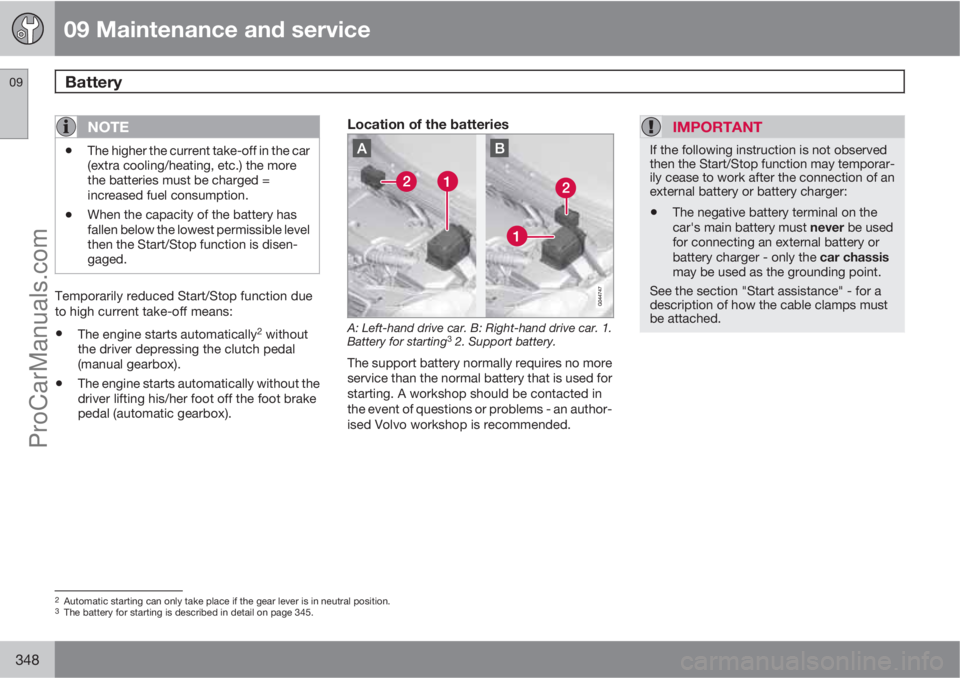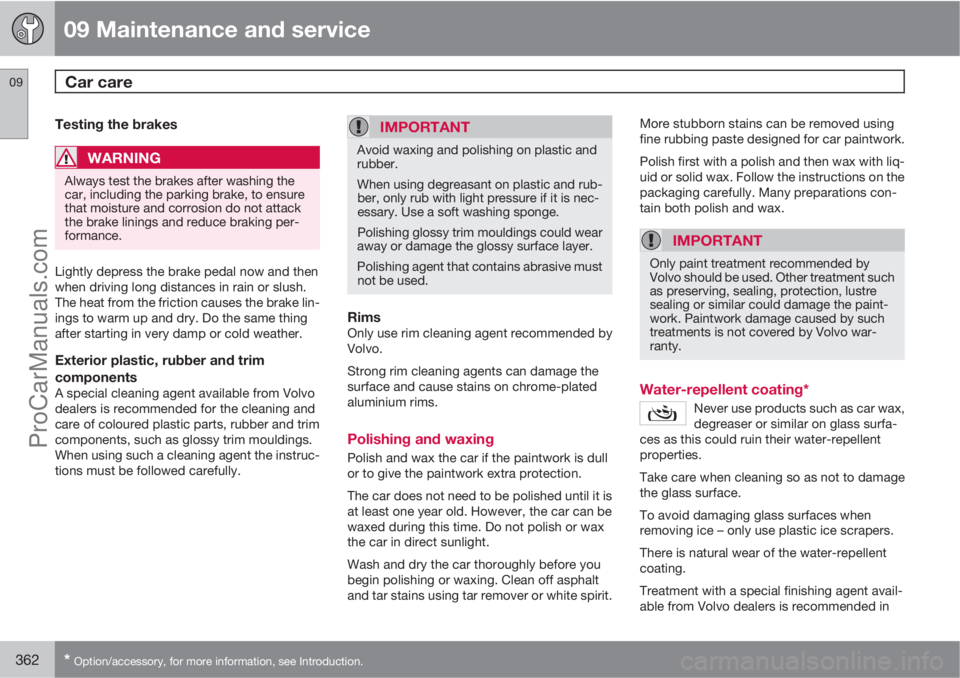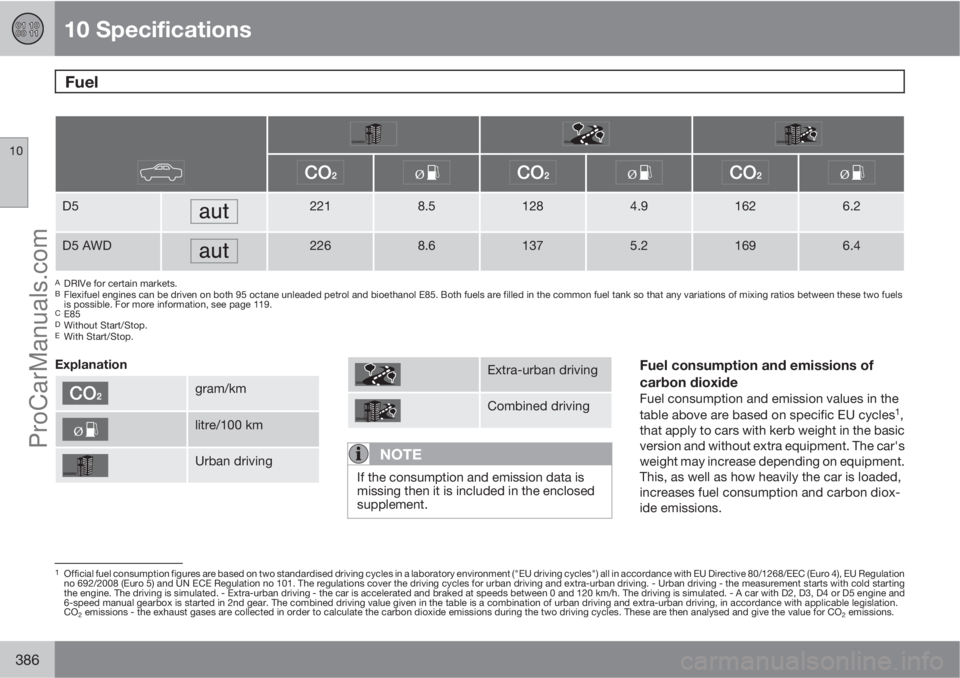Page 350 of 422

09 Maintenance and service
Battery 09
348
NOTE
•The higher the current take-off in the car
(extra cooling/heating, etc.) the more
the batteries must be charged =
increased fuel consumption.
•When the capacity of the battery has
fallen below the lowest permissible level
then the Start/Stop function is disen-
gaged.
Temporarily reduced Start/Stop function due
to high current take-off means:
•The engine starts automatically2 without
the driver depressing the clutch pedal
(manual gearbox).
•The engine starts automatically without the
driver lifting his/her foot off the foot brake
pedal (automatic gearbox).
Location of the batteries
A: Left-hand drive car. B: Right-hand drive car. 1.
Battery for starting3 2. Support battery.
The support battery normally requires no more
service than the normal battery that is used for
starting. A workshop should be contacted in
the event of questions or problems - an author-
ised Volvo workshop is recommended.
IMPORTANT
If the following instruction is not observed
then the Start/Stop function may temporar-
ily cease to work after the connection of an
external battery or battery charger:
•The negative battery terminal on the
car's main battery must never be used
for connecting an external battery or
battery charger - only the car chassis
may be used as the grounding point.
See the section "Start assistance" - for a
description of how the cable clamps must
be attached.
2Automatic starting can only take place if the gear lever is in neutral position.3The battery for starting is described in detail on page 345.
ProCarManuals.com
Page 359 of 422
09 Maintenance and service
Fuses09
��
* Option/accessory, for more information, see Introduction.357
Box BFunctionA
--
Brake light5
Sunroof*20
Immobiliser5
ProCarManuals.com
Page 360 of 422
09 Maintenance and service
Fuses 09
358* Option/accessory, for more information, see Introduction.
Cargo area
Positions
FunctionA
Electric parking brake, left30
Electric parking brake, right30
Rear window defroster30
Trailer socket 2*15
FunctionA
--
12 V socket, cargo area15
--
--
FunctionA
--
--
Trailer socket 1*40
--
ProCarManuals.com
Page 364 of 422

09 Maintenance and service
Car care 09
362* Option/accessory, for more information, see Introduction.
Testing the brakes
WARNING
Always test the brakes after washing the
car, including the parking brake, to ensure
that moisture and corrosion do not attack
the brake linings and reduce braking per-
formance.
Lightly depress the brake pedal now and then
when driving long distances in rain or slush.
The heat from the friction causes the brake lin-
ings to warm up and dry. Do the same thing
after starting in very damp or cold weather.
Exterior plastic, rubber and trim
components
A special cleaning agent available from Volvo
dealers is recommended for the cleaning and
care of coloured plastic parts, rubber and trim
components, such as glossy trim mouldings.
When using such a cleaning agent the instruc-
tions must be followed carefully.
IMPORTANT
Avoid waxing and polishing on plastic and
rubber.
When using degreasant on plastic and rub-
ber, only rub with light pressure if it is nec-
essary. Use a soft washing sponge.
Polishing glossy trim mouldings could wear
away or damage the glossy surface layer.
Polishing agent that contains abrasive must
not be used.
RimsOnly use rim cleaning agent recommended by
Volvo.
Strong rim cleaning agents can damage the
surface and cause stains on chrome-plated
aluminium rims.
Polishing and waxing
Polish and wax the car if the paintwork is dull
or to give the paintwork extra protection.
The car does not need to be polished until it is
at least one year old. However, the car can be
waxed during this time. Do not polish or wax
the car in direct sunlight.
Wash and dry the car thoroughly before you
begin polishing or waxing. Clean off asphalt
and tar stains using tar remover or white spirit.More stubborn stains can be removed using
fine rubbing paste designed for car paintwork.
Polish first with a polish and then wax with liq-
uid or solid wax. Follow the instructions on the
packaging carefully. Many preparations con-
tain both polish and wax.
IMPORTANT
Only paint treatment recommended by
Volvo should be used. Other treatment such
as preserving, sealing, protection, lustre
sealing or similar could damage the paint-
work. Paintwork damage caused by such
treatments is not covered by Volvo war-
ranty.
Water-repellent coating*
Never use products such as car wax,
degreaser or similar on glass surfa-
ces as this could ruin their water-repellent
properties.
Take care when cleaning so as not to damage
the glass surface.
To avoid damaging glass surfaces when
removing ice – only use plastic ice scrapers.
There is natural wear of the water-repellent
coating.
Treatment with a special finishing agent avail-
able from Volvo dealers is recommended in
ProCarManuals.com
Page 376 of 422
10 Specifications
Dimensions and weights
10
374
Towing capacity and towball load
EngineEngine codeAGearboxMax. weight braked trailer (kg)Max. towball load (kg)
T3B4164T3Manual, MMT6160075
T3B4164T3Automatic, MPS6160075
T4BB4164TManual, MMT6160075
T4BB4164TAutomatic, MPS6160075
T4CB5204T8Automatic, TF-80SD180090
T4FB4164T2Manual, MMT6160075
T4FB4164T2Automatic, MPS6160075
T5B4204T7Manual, MMT6180090
T5B4204T7Automatic, MPS6180090
T5CB5204T9Automatic, TF-80SC180090
T5CB5254T12Automatic, TF-80SC180090
T6 AWDB6304T4Automatic, TF-80SC180090
D2D4162TManual, MMT6130075
D2D4162TAutomatic, MPS6130075
D3D5204T7Manual, M66160075
D3D5204T7Automatic, TF-80SDE160075
ProCarManuals.com
Page 377 of 422
10 Specifications
Dimensions and weights
10
375
EngineEngine codeAGearboxMax. weight braked trailer (kg)Max. towball load (kg)
D4D5204T3Manual, M66160075
D4D5204T3Automatic, TF-80SCD160075
D4D5204T3Automatic, TF-80SDE160075
D4 AWDD5244T17Automatic, TF-80SC180090
D5D5244T11Manual, M66160075
D5D5244T15Automatic, TF-80SC180090
D5 AWDD5244T15Automatic, TF-80SC180090
AEngine code, component and serial number can be read on the engine, see page 370.BDRIVe for certain markets.COnly certain markets.DWithout Start/Stop.EWith Start/Stop.
Max. weight unbraked trailer (kg)Max. towball load (kg)
75050
ProCarManuals.com
Page 384 of 422
10 Specifications
Fluids and lubricants
10
382
Other fluids and lubricants
Manual gearboxVolume (litres)Prescribed transmission fluid
MMT61.7BOT 350M3M661.9
Automatic gearboxVolume (litres)Prescribed transmission fluid
MPS67.3BOT 341
TF-80SC7.0AW1
TF-80SD7.0AW1
FluidSystemVolume (litres)Prescribed grade
Brake fluidBrake system0.6DOT 4+
Power steering fluidPower steering-WSS M2C204-A2 or equivalent product.
Washer fluidCars with headlamp washing5.4Washer fluid recommended by Volvo - with frost protection during
cold weather and below freezing point.
Cars without headlamp washing4.0
FuelPetrol engineapprox. 67Petrol: see page 288
Diesel engineapprox. 67Diesel: see page 289
ProCarManuals.com
Page 388 of 422

10 Specifications
Fuel
10
386
D52218.51284.91626.2
D5 AWD2268.61375.21696.4
ADRIVe for certain markets.BFlexifuel engines can be driven on both 95 octane unleaded petrol and bioethanol E85. Both fuels are filled in the common fuel tank so that any variations of mixing ratios between these two fuels
is possible. For more information, see page 119.
CE85DWithout Start/Stop.EWith Start/Stop.
Explanation
gram/km
litre/100 km
Urban driving
Extra-urban driving
Combined driving
NOTE
If the consumption and emission data is
missing then it is included in the enclosed
supplement.
Fuel consumption and emissions of
carbon dioxide
Fuel consumption and emission values in the
table above are based on specific EU cycles1,
that apply to cars with kerb weight in the basic
version and without extra equipment. The car's
weight may increase depending on equipment.
This, as well as how heavily the car is loaded,
increases fuel consumption and carbon diox-
ide emissions.
1Official fuel consumption figures are based on two standardised driving cycles in a laboratory environment ("EU driving cycles") all in accordance with EU Directive 80/1268/EEC (Euro 4), EU Regulation
no 692/2008 (Euro 5) and UN ECE Regulation no 101. The regulations cover the driving cycles for urban driving and extra-urban driving. - Urban driving - the measurement starts with cold starting
the engine. The driving is simulated. - Extra-urban driving - the car is accelerated and braked at speeds between 0 and 120 km/h. The driving is simulated. - A car with D2, D3, D4 or D5 engine and
6-speed manual gearbox is started in 2nd gear. The combined driving value given in the table is a combination of urban driving and extra-urban driving, in accordance with applicable legislation.
CO
2 emissions - the exhaust gases are collected in order to calculate the carbon dioxide emissions during the two driving cycles. These are then analysed and give the value for CO2 emissions.
ProCarManuals.com